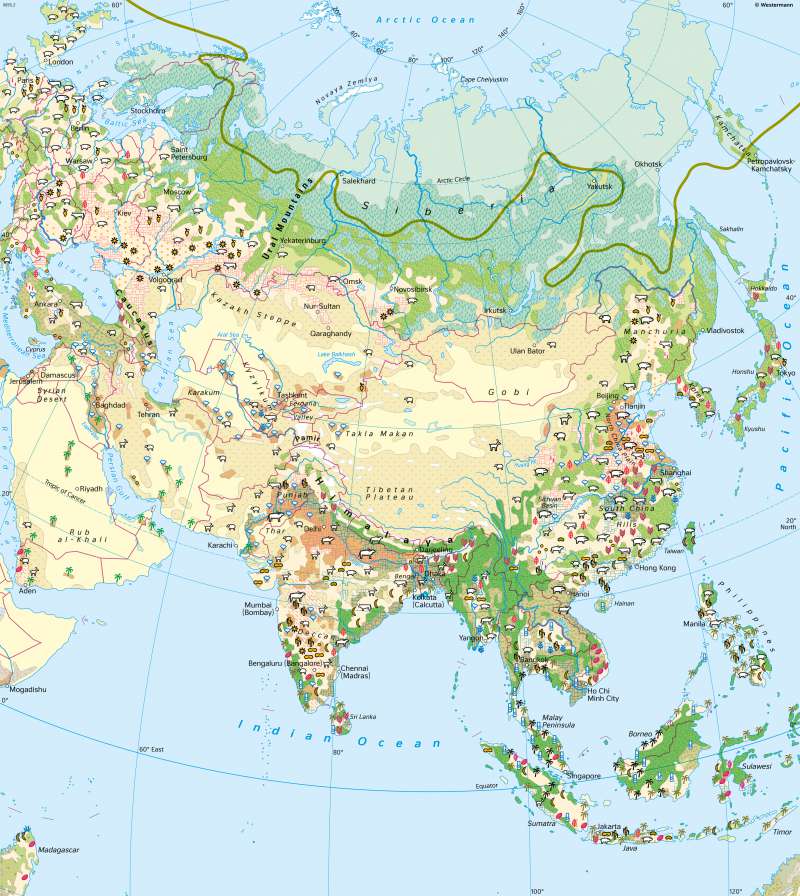Asia - Land cover and agriculture
Agriculture and climate
978-3-14-100890-6 | Page 120 | Ill. 1

Overview
Asia is not only the largest continent on earth, but also the most diverse, which can especially be seen in its agriculture. Because agriculture in all regions has to adapt to the respective conditions, be it in terms of climate, surface shape or precipitation, a wide variety of agricultural uses prevail in the different vegetation zones and regions. In addition, there are unfavourable areas such as the highlands of Tibet, a cold desert 4000 to 5500 metres above sea level, in which agricultural use is hardly possible.
Land use in Asia
Large parts of Inner Asia, the Near East and the Arabian Peninsula are characterised by oasis and irrigation cultures with cotton and date palm cultivation. Particularly striking are the river oases on the Euphrates (Syria, Iraq), Amudarya (Afghanistan, Tajikistan, Uzbekistan, Turkmenistan), Sydarya (Kazakhstan, Uzbekistan, Tajikistan), and Indus (Pakistan).
The drier parts of Asia are characterised by extensive livestock farming. Originally, it was mostly practiced by nomadic pastoralists. Today, this form of agricultural use is declining in all countries. This development is due to economic as well as cultural and socio-political reasons.
In the northern parts of Siberia, the timber industry dominates. The special temperature and precipitation conditions only permit extensive cereal cultivation in western Siberia (as far as Kazakhstan), which dissolves into islands towards the east, also for reasons of surface structure. Livestock farming only plays a major role in Kazakhstan.
Large parts of eastern China provide a vivid example of areas where there is intensive agricultural use. Wheat and maize are the most important crops in the northern parts of the country (Great Plains, Manchuria), while peanuts are the most important source of oil. Rice is the dominant crop in the south, complemented by sugar cane, tea, peanuts, and vegetables. In the south, water buffaloes, which are indispensable for rice cultivation, play an important role in livestock farming. In the livestock sector, pig farming predominates in China.
The Indian subcontinent is similarly diverse as China. In many places, arable farming has had to adapt to the seasonal change between rainy and dry seasons. In the Himalayan region, a hygric east-west contrast can be seen. Total precipitation decreases continuously from east (dominated by rice) to west (dominated by wheat). Due to the seasonal distribution of rain, irrigated crops are widespread. Millet dominates as a staple food in the drier south of India; only on the coasts favoured by rainfall, especially in the west, rice cultivation is possible. Coconut palms and peanuts also serve as the most important fat suppliers here.
For Bangladesh, the cultivation of jute is of particular importance. Almost the entire world production of jute, which requires a humid tropical climate for its growth, comes from India and Bangladesh. The 3 to 4 metre high, reed-like plant has been planted in the Ganges delta since the end of the 19th century. Since agriculture is still of great economic importance in the developing country of Bangladesh and jute is its main product along with rice, large parts of the population are dependent on the jute economy.
Southeast Asia is characterised by a dramatic decline in tropical rainforests. Timber is still an important export item for these countries, and slash-and-burn agriculture has led to the destruction of the original forests, especially in Malaysia and Indonesia. They are widely carried out for the purpose of expanding arable land for the establishment of oil palm plantations, because the demand for palm oil on the world market has multiplied in the last 25 years; Malaysia and Indonesia now cover a large part of the world's production.
Other important agricultural products of Southeast Asia are rubber, coconuts (both from plantations) and rice. In the Philippines, sugarcane is replacing rubber. A large part of these products is relevant for the countries’ export. The problems of human use or overuse of tropical forests are as acute in this region as they are in the Amazon.
Another major problem in Asian agriculture today is soil salinisation in the irrigated areas caused by rising groundwater. About 30 percent of the farmland is affected, especially along the lower Indus River and in the region around the Aral Sea.




